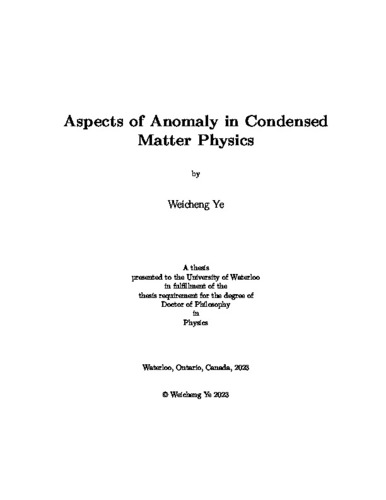| dc.description.abstract | Anomalies have proven to be an important tool for unraveling the enigmatic properties of strongly-coupled condensed matter systems. Especially, it provides powerful constraints on the emergibility problem, i.e., whether a quantum phase or phase transition can emerge in a many-body system. In this thesis, the focus is mainly on $(2+1)$-dimensional bosonic systems, and we explain how to identify the anomaly of various interesting systems in this category. We then apply these results to study the emergibility of a class of quantum critical states known as Stiefel Liquid, and discuss several interesting realizations uncovered using results from anomaly.
First of all, for a $(2+1)$-d lattice spin system, we derive the topological partition functions that characterize the Lieb-Schultz-Mattis constraints with $G_s\times G_{int}$ symmetry, where $G_s$ is an arbitrary space group in two spatial dimensions, and $G_{int}$ is any internal symmetry whose projective representations are classified by $(\mathbb{Z}_2)^k$ with $k$ an integer. This LSM anomaly will be matched with the anomaly of IR states. We then calculate the anomaly of several IR states. One class of IR states we discuss is the recently-proposed Stiefel Liquid, with the well-known Deconfined Quantum Critical Point (DQCP) and U(1) Dirac Spin Liquid (DSL) unified as two special examples. We introduce the description of Stiefel Liquid using non-linear Sigma Model and explain how to get the anomaly from such description. Another class of IR states we consider is $(2+1)$-d symmetry-enriched topological order. And we explain the framework of getting the anomaly of topological order with a general symmetry action by identifying a $(3+1)$-d topological quantum field theory whose boundary hosts the original $(2+1)$-d symmetry-enriched topological order.
Finally, we apply these results and the framework of anomaly-matching to understand the emergibility of Stiefel Liquid, including
DQCP, DSL, and the so-called non-Lagrangian Stiefel liquid. These states can emerge as a consequence of the competition between a magnetic state and a non-magnetic state. We identify all possible realizations of these states on systems with $SO(3) \times \mathbb{Z}_2^T$ internal symmetry and either $p6m$ or $p4m$ lattice symmetry. Many interesting examples are discovered, including a DQCP adjacent to a ferromagnet, stable DSLs on square and honeycomb lattices, and a class of quantum critical spinquadrupolar liquids of which the most relevant spinful fluctuations carry spin-2. In particular, there
is a realization of spin-quadrupolar DSL that is beyond the usual parton construction. | en |

